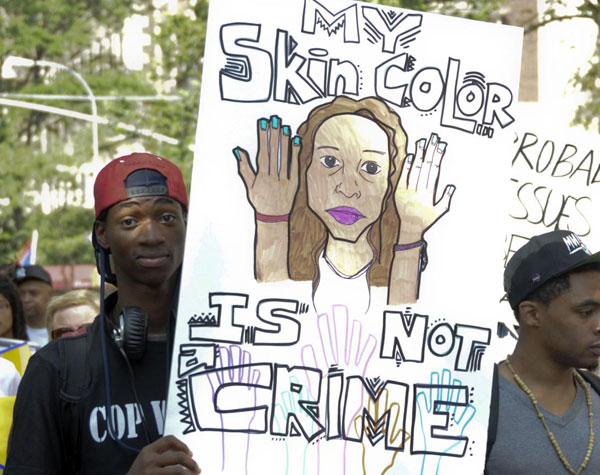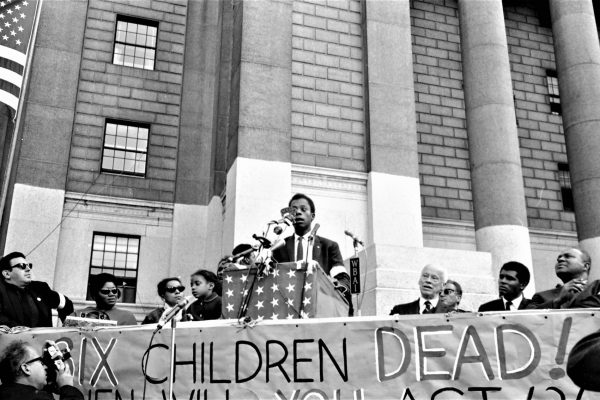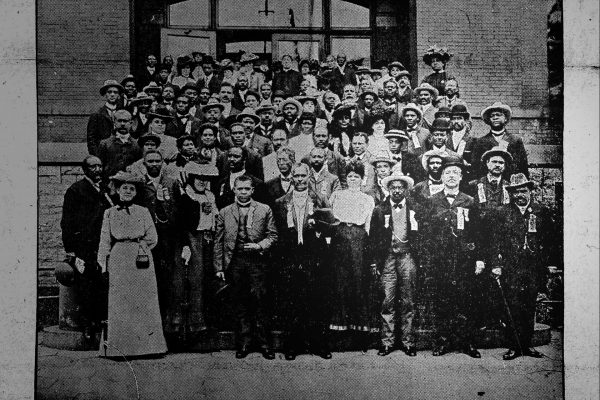In Philip K. Dick’s 1956 dystopian short story “The Minority Report,” crime has been eradicated—at a cost. The justice system process has been reversed: rather than punishing past infractions, the Precrime Division uses “precog” psychics to foresee future crimes. Rather than solving them after they have happened, the division targets crimes in a hypothetical, indeterminate future. Convictions based upon psychic prediction are ineligible for appeal, trading civil liberties for security. Innocents caught in the margin of error are sacrificed to keep the communal peace.
In late September, Republican presidential candidate Donald Trump proposed a nationwide expansion of the stop-and-frisk policing best known for the constitutional challenges it has faced in New York. In many ways, stop-and-frisk policing has its foundation in a theory of criminality that is eerily similar to Dick’s precrime—with all the attendant legal and moral problems. Stop-and-frisk is based on the premise that police officers can preempt crime through predicting which people are likely to be—or become—criminals. In practice, the policy involves sweeps for those who “fit the description” of criminality. Stop-and-frisk has its origins in the logic of broken-windows policing, a social theory targeting people and neighborhoods deemed suspicious or disorderly for heightened surveillance and enforcement. Under stop-and-frisk, entire neighborhoods—and black and Latino men more generally—were deemed suspicious, criminalized, and deprived of constutional rights.
The singular accomplishment of stop-and-frisk was the worsening of racial inequality: 85 percent of those stopped were innocent black and Latino men.
In his story, Philip K. Dick’s precrime at least had the virtue of working: the precogs’ visions reduced “felonies by ninety-nine and a decimal point eight percent,” and murders and assaults were eliminated—though at the price of the suspension of civil liberties. Stop-and-frisk policing likewise infringes upon civil liberties—treating the black urban poor as merely latent criminals—but unlike precrime it does not work, in stark contrast to Trump’s baseless claim that it has worked “incredibly well.” In fact, its singular accomplishment has been the exacerbation of racial inequality: according to the New York Police Department’s own statistics, 85 percent of those stopped under stop-and-frisk were innocent black and Latino men. Despite this, whites who were stopped under the policy were more likely to be carrying contraband. In order to fully understand stop-and-frisk and its failings, it is necessary to understand the history of its precursor, broken windows, both of which have entrapped minorities in cycles of criminalization and incarcertaion in the name of achieving what Bernard Harcourt calls an “illusion of order.”
In 1982 The Atlantic published “Broken Windows,” an article by sociologist George L. Kelling and noted political scientist and conservative theorist James Q. Wilson. In their article, the two argue that a single broken window in a neighborhood shows potential criminals that “no one car[es]” about social disorder. According to broken-windows theory, visible symbols of disorder—litter, graffiti, the homeless, loiterers—can activate latent criminality. As a purported success story, Kelling and Wilson highlight the results of New Jersey’s Safe and Clean Neighborhoods Program, which returned beat cops to foot patrols under the assumption that contact with community members reduces crime. Empirically, Safe Neighborhoods did not reduce crime rates. However, some residents in the areas where more cops were on foot patrol claimed they felt safer. Kelling and Wilson accepted this comforting illusion of safety as proof of the program’s success, despite data that the program did nothing to actually increase community safety.
Wilson and Kelling recognized that their link between crime and “disorder” was tenuous, freely substituting evidence for conjecture. For the foundation—and name—of their new social policy, the pair drew on research from Stanford social psychologist Philip Zimbardo, which showed that cars left unattended with a broken window were quickly destroyed by vandals. From this single piece of evidence, Wilson and Kelling extrapolated that minor infractions are inevitable precursors to more serious crimes. Indeed, such infractions may be so minor that they are not even crimes; all such “precrime” deviations from normative behavior are seen by Kelling and Wilson to be bellweathers of more grave, future criminality. Thus, normative values regarding the use of public space must be ruthlessly protected. Wilson and Killing were particularly disturbed that, in Zimbardo’s experiments, even “apparently clean-cut” and “respectable whites” were latent vandals. In their essay, they speculate that if whites could become so quickly unmoored from social proprieties when confronted with disorder, it is a much shorter trip for the poor and people of color. Contextual disorders of the city were written onto the bodies of disorderly people.
“Broken Windows” neatly solved two problems for Reagan-era conservatives: race relations and social disorder. Its focus on deviations from bourgeois respectability, as opposed to actual crimes, universalized white middle-class norms. By advocating for ridding the streets of “disorderly people”—“not violent people, nor, necessarily, criminals, but disreputable or obstreperous or unpredictable people”—Wilson and Kelling make inalienable rights distinctions of taste. In their essay, they long for a time when “rights were something enjoyed by decent folk” who could “afford a lawyer.” Freedom of association, protection from unreasonable searches, and due process become less important than a feeling of safety—for those who matter. In short, recession, widespread unemployment, and alienation were not what was causing problems in society. Rather, a class of people—black, poor, so naturally prone to criminality—was directly responsible for the upheaval plaguing America’s cities.
Bias was fine as long as everyone agreed to call it something else.
Science fiction, so often criticized for imagining a world absent of minorities, nonetheless often speaks to the lived realities of people of color. There is no mention in “Minority Report” of the precogs targeting the poor or minorities—prediction, and the imperfect justice it represents, is ostensibly impartial. Nonetheless, the plot of “Minority Report” revolves around the existential horror experience by its protagonist, Anderton, founder of the Precrime Division, when he is named by the precogs as a future murderer. In other words, precrime is fine to Anderton so long as it targets others; it is a wholly different matter to find it turned on himself. Similarly for Wilson and Kelling, disorder was a quality intrinsic to the other. As such, Wilson and Kelling were by nature securely exempt—as is Trump—from the surveillance they promoted, insulated from its grievous effect on minority and poor communities.
Underlying Wilson and Kelling’s concern for social disorder was the live question of how American conservatives would negotiate a post–civil rights landscape. The text is precariously balanced between an open Jim Crow–style racism and an emerging but not yet consolidated adoption of colorblind rhetoric. A key innovation of “Broken Windows” was the rhetorical repackaging of racially-biased policing in neutral—or at least plausibly deniable—terms. Bias was fine as long as everyone agreed to call it something else.
Claiming that Wilson and Kelling accepted racially-biased policing sounds hyperbolic; it isn’t. They write that they have no “satisfactory answer” to the question of how to prevent broken-windows policing from devolving into crude racial profiling based on “skin color or national origin.” In place of policy safeguards they offer “hope” that police training and goodwill will prevent officers from using race as the basis of “distinguishing the undesirable from the desirable.” Ultimately, however, racial bias was an acceptable risk. In the war against perceived disorder, people of color were acceptable collateral damage.
A social theory rarely becomes a matter of public policy unless it acquires a powerful champion for whom it is politically expedient. This is why it is so tremendously dangerous that Trump has made stop-and-frisk a component of his presidential campaign. Community policing initiatives have a long history, from the Black Panthers’ armed patrols targeting police brutality to New York Mayor David Dinkins’s attempt to allow more local input into policing. These programs, however—grounded in the needs of black communities—have never been adopted at the scale of broken-windows policing. They did not have a Bill Bratton, who used the theory as both a revolutionary manifesto and as leverage for career advancement. Of course, broken-windows policing did not become doctrinal through Bratton’s will alone. Broken windows appealed to the post–civil rights imperative of avoiding direct racial appeals while coddling old prejudices. Social science theory provided an objective gloss that conveniently reinforeced the racial common sense.
An ambitious Vietnam veteran, Bratton combined hardnosed style and public relations showmanship, rapidly rising from Boston cop to head of New York City transit police, then to commissioner of the Boston police force (1993–94), a position he used to implement broken-windows policing throughout the city. Thereafter Bratton was recruited as commission of New York police (1994–96) and commissioner of the Los Angeles Police Department (2002–9), largely based on the perceived success of broken windows. Bratton then returned to New York as commissioner of police (2014–16), by then advocating for stop-and-frisk, broken windows’ millennial rebranding.
Disturbed by the disorder he perceived upon returning from Vietnam, Bratton focused as Boston commissioner of police on the prosecution of low-level vandalism, an obsession that many credited with lowering crime rates in the city. Sensing a kindrid spirit, Kelling had earlier recruited Bratton to run the New York City transit police (1990–92), for which Kelling was serving as a consultant. Once there, Bratton combined an increasing militarization of transit cops with zero tolerance for minor crimes such as panhandling. At the time he joined the force, morale in its ranks was low: minimal enforcement meant that most transit cops saw little action. Few crimes were committed, and actual infractions were typically low-level, such as fare jumping and panhandling, considered unworthy of pursuit. In line with how many Americans mistakenly believe that police continue to operate, officers were waiting for actual criminal acts before citizens became suspects. But in fact, under Bratton’s tutelage this changed, as it has for many American police forces.
Broken-windows policing swaps deviations from white, bourgeois respectability for the openly racist practices of Jim Crow.
Bratton embraced big data before it was cool. Aggressive policing was coupled with a rigorous use of statistics to track the location of crimes and interactions with civilians. This system of policing pioneered by Bratton would come to be known as CompStat. It was developed by one of Bratton’s transit police lieutenants, Jack Maple, who originally called it by the dystopian name “charts of the future.” Maple and then Bratton believed that by assiduously tracking all police interactions, underlying patterns of criminality could be discerned and even predicted—a kind of precrime insight. Beat officers were largely unhappy about embracing this element of Bratton’s revolution, as it could easily—and in many precincts did—become a numbers-driven quota system forcing officers into unnecessary interactions. According to Christian Parenti, when CompStat was adopted throughout the NYPD in 1994 when Bratton became commissioner, the “meetings were so rough that half of New York’s seventy-six precinct captains quit or were transferred from their jobs in the first two years.” Officers were resistant to what was essentially both a work speedup and transformation of police work necessitated by CompStat’s relentless bottom-line focus. Incentivized to make quotas, interactions with civilians became fraught.
The timing of New York’s implementation of these tactics so perfectly coincided with a period of right-wing tough-on-crime politicking—notably another of Trump’s rallying cries—that broken-windows policing was quickly embraced by forces across the country. In support of the perceived success and right-mindedness of broken windows, its advocates often note that this period of its widespread adoption correlates with a national decline in crime. But criminologists argue that there is no credible way to attribute the decrease in crime to these aggressive new tactics. Crime fell in areas that adopted these policies—as well as in those that didn’t. And in fact, when a judge halted New York’s use of stop-and-frisk in 2013, violent crime dropped.
Therefore, what broken windows contributed to the overall falling crime rate remains unclear. But what is absolutely clear is that, whatever causality did or did not exist, the cost borne by communities of color and the poor was too high. Broken windows, by definition, calls for the overpolicing of communities of color, channeling many into the criminal justice system to their lifelong detriment and to the impoverishment of their communities. Because discretion is built into broken-windows policing, what counts as “disorder” is inevitably refracted through a racial lens. To demonstrate this, sociologists Robert Sampson and Stephen Raudenbush videotaped neighborhoods with “objective” signs of disorder—litter, graffiti, etc.—and showed these videos to research subjects. They found that including black residents in the video led participants to conclude a neighborhood was more disorderly, regardless of its objective characteristics. Racial perceptions invert the classic dictum. When it comes to perceiving disorder, racism makes believing into seeing.
Bratton’s application of broken windows fundamentally transformed policing. But innovations were a change of degree rather than of kind, as race has always been central to policing in the United States. Broken-windows theory swapped deviations from bourgeois respectability for the openly racist practices of prior regimes. Black codes that criminalized everyday life, Jim Crow–era restrictions on the use of public space, and stop-and-frisk policies grounded in broken-windows philosophy are points on the same spectrum of what Michelle Alexander calls “racialized social control.” Although most of these laws have been superficially colorblind, in both their conception and application they have always been deeply racialized, focused more on regulating the lives of people of color than on the prevention of crime.
A focus on perceptions of disorder, rather than actual crimes committed, unavoidably invites police to people their environments with the racial stereotypes that fill their imaginations. “Disorder” is subjective and largely affective. Given the longstanding association of blackness with criminality, it is unsurprising that broken-windows policies have produced such racially biased policing. If one were attempting to design a policy that would target people of color and the poor, it would be hard to surpass the effectiveness of broken windows.
Broken-windows policing creates the very disorder that it claims to be remedying. As historian Khalil Gibran Muhammad points out, statistics on race and petty crime are always partially an artifact of where officers place their attention. Although data on stops and arrests are presented as objective facts about racial differences in crime rates, the policing attention showered on communities of color produces the statistics that are then used as justification for more policing. Police officers cannot, after all, intuit who will commit a crime, although prior infractions are often used retroactively to tarnish the character of victims. Unlike in Dick’s story, foolproof prediction remains impossible.
Broken windows and stop-and-frisk terrorize communities of color. The deaths of black men, women, and children at the hands of police are the inevitable output of a social policy that inherently devalues black lives and sees black communities as inimical to order. Mistaking the results of economic problems and systemic racism—unemployment, homelessness, addiction—for causes, broken windows and its ilk punish oppressed communities for failing to resolve wider social ills that originate beyond them.
By heavily policing communities of color seen as “broken,” policing has become unmoored from actual crime. Broken windows and the community-policing initiatives it spawned have contributed to the crisis of legitimacy that police departments across the country now face. Wilson and Kelling predicted racially-biased policing, and it became policy anyway. The recent Justice Department reports on Ferguson and Baltimore, which carefully document the day-to-day texture of America’s epidemic of racially-biased policing, should definitively undermine broken-windows philosophy. Instead, in this election we face a dystopian choice as Trump draws on the perennial appeal of racially-biased policing.








